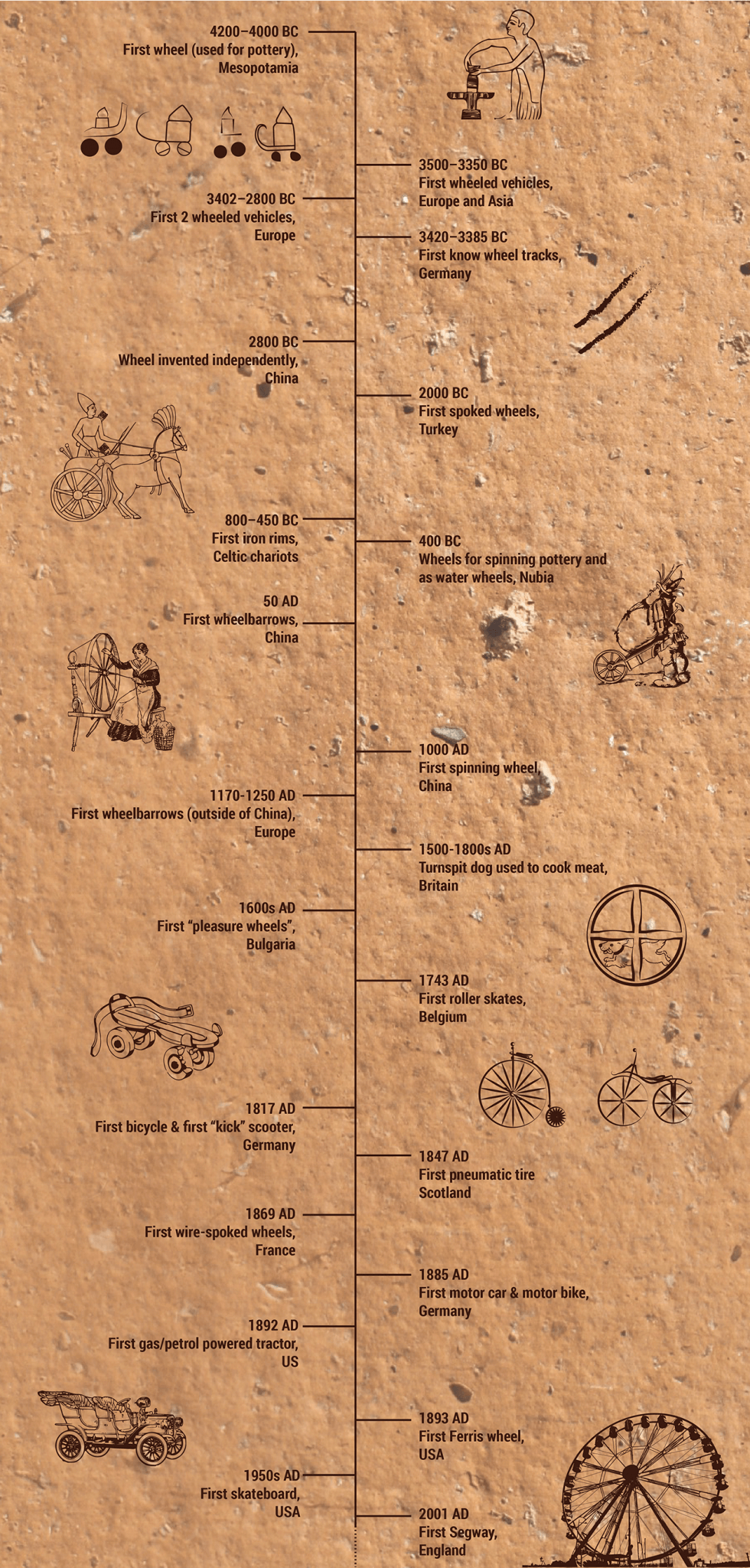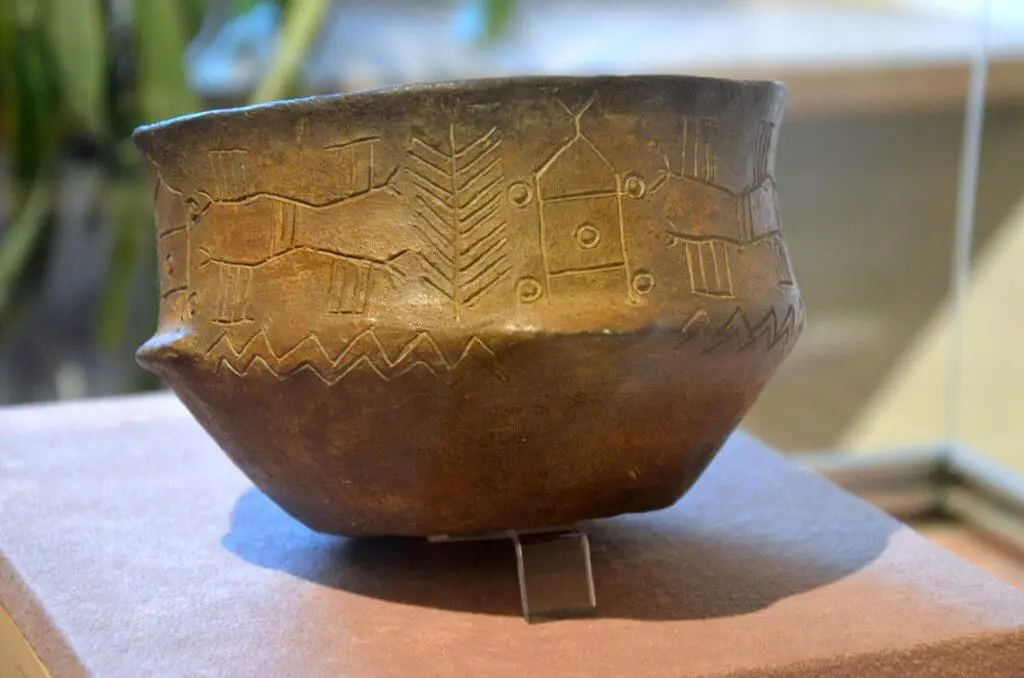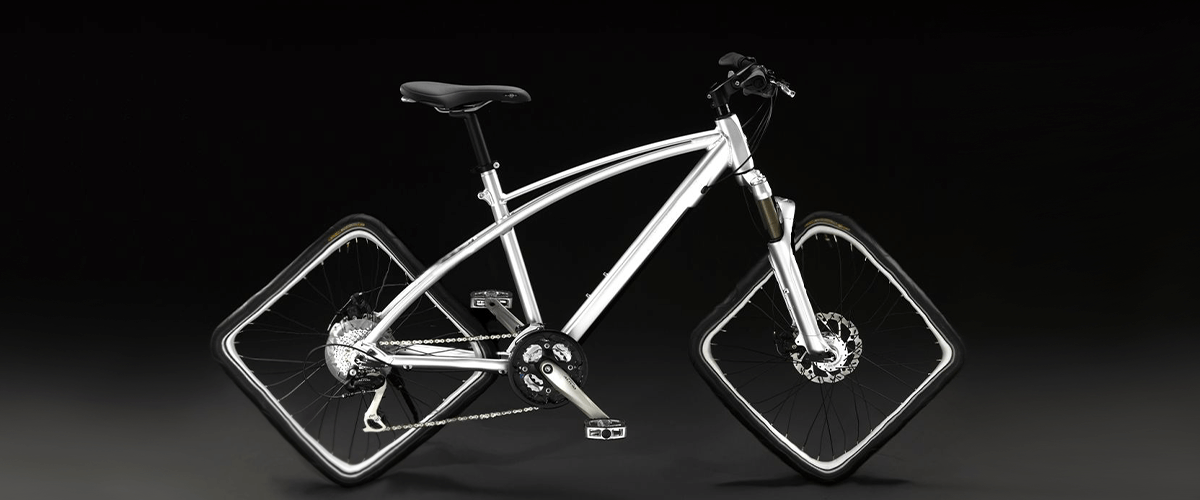Who invented the wheel and when? What is the Mesopotamian Wheel?
The wheel might not be as old as you think!
Did you know: art, pottery, the flute, wine, and makeup, were all invented before the wheel?
Earliest Evidence
The earliest evidence for the wheel is…
4200–4000 BC, these were used for pottery. Because the wheel was invented before records were kept, nobody can ever know who invented the wheel. The earliest wheeled vehicles were somewhere between 3500–3350 BC. The invention was quickly adopted across parts of Europe and Asia. Before this sleds were used to move large and heavy objects across the land. The domestication of horses and road infrastructure played a pivotal role in the adoption of the wheel as a form of transport.

Who invented the wheel?
Because the wheel was invented before records were kept, nobody can ever know who invented the wheel, or even which tribe had the idea. However, the ancient Mesopotamian people are widely believed to have invented the wheel around 4200--4000 BC, It is likely to have also been invented, independently in China, around 2800 BC.

Map showing the extent of Mesopotamia.
The first wheels were potter's wheels and were not used for transportation, known as "Tourettes" or "slow wheels".

One archeologist has claimed to find evidence of a toy, a stone "car" that dates to around 5500. However, evidence for this date remains unclear and the original publication has been taken down.
How did they move large objects before the wheel?
Before the invention of the wheel, large/heavy objects were typically dragged on some form of the sled.

megaliths moved by the Nias island off the western coast of Sumatra, Indonesia -- circa 1915 -- Collectie Stichting Nationaal Museum van Wereldculturen
Now you might be thinking, "But hey, monuments like Stonehenge (3000 BC) used a crude, early form of the wheel: logs to roll the stones across the earth!" However, somewhat bizarrely, archaeologists are increasingly starting to think that these stones were moved using a sledge with some form of lubricant, for example, pig lard. The same is true for the Pyramids (2589 and 2504 BC), one theory suggests that the large rocks were dragged on sleds and that water was poured on the sand to reduce friction.
When was the first wheeled vehicle invented?
Somewhere around 3500--3350 BCE, the first wheeled vehicles emerged across parts of Europe and Asia. No one is sure whether it was a simultaneous invention or a fast-paced adoption of the new technology.
Again, because records were not kept, we can never know for sure, the name of the first man, or woman to use the wheel for transportation.

The Bronocice pot, found in a Neolithic village in Poland. 3,635 -3,370 B.C., depicts what is thought to be the earliest known representation of a wheeled vehicle. The vehicle is drawn in a top-down view, with the wheels drawn from side views. Silar / CC BY-SA
Early, wheeled vehicles were almost certainly 4 wheeled. The earliest known depictions of wheeled vehicles: the Bronocice pot, found in a Neolithic village in Poland. 3,635 -3,370 BC, and several clay tablets found in Uruk -- Iraq. Both illustrate 4 wheeled vehicles dated to around 3300-3100 BC.

Although somewhat crude, these symbols found on several clay tablets -- Uruk -- Iraq point towards the use of wheeled carts. Many similar, unwheeled symbols, can be found on the same sets of tablets. Dated to around 3300-3100 BC.
A series of parallel tracks were found, near Kiel, Germany, that date to around 3420--3385 BC. Because the tracks are "wobbly" archaeologists believe that these were track marks from a wheeled vehicle and not a sled.
2 wheeled vehicles came along slightly later. The first known depiction is dated 3402--2800 BC and was found in a grave gallery, in Lohne-Engelshecke, Germany.
Why did it take so long to invent the wheel?
Although the concept may seem super simple to us 21st-century apes. The wheel is a wholly human invention, that is to say, it doesn't appear anywhere in nature. Factors such as road infrastructure and the domestication of large animals capable of pulling wheeled vehicles eg. horses, also played a pivotal role in the adoption of the wheel.
The evolution of the wheel
Whilst the first wheels were most likely, solid disks or even sliced tree trunks. They didn't stay that way for long.
Spoked Wheels
The spoked wheel was invented around 2000 BC in Anatolia (Turkey). Spokes made the wheels lighter giving the Sintashta an upper hand in warfare. Spoked wheels have been found in graves that date back as late as 2100-1800 BC.
Wire-spoked wheels didn't emerge until the 1870s. We have invention of the bicycle to thank for this.
Axels
In Switzerland and Germany, the first wheels were fixed to a rotating axle on a square mortise. Meaning that the wheels turned with the axel. However, in other areas, the axle was fixed and the wheels rotated independently. The free-moving wheel design had a distinct advantage when it came to cornering.
Tires
The tire is perhaps, yet another invention that can be claimed by the Scots.
Celtic chariots (800--450 BC) are the first known examples to use an iron rim around the wheel.

The first patent for a pneumatic tire was issued in 1847 by the Scottish inventor Robert William Thomson. The first mass-produced tire was made in 1888 on May Street, Belfast, by another Scot: John Boyd Dunlop. He designed it to reduce the headaches his son suffered when riding his tricycle.
The wheel outside of Europe and Asia
As early as 1500 BCE, the indigenous peoples of North America used wheels to create toys, such as animals with wheeled legs. However, the wheel was not widely used for transportation until the arrival of European settlers. One explanation for this is that there were no domesticated animals, suitable for pulling vehicles in America until this point.

Wheeled toys, similar to this one have been found in northern North America long before the wheel was used in transportation. This particular example is an Ancient Greek child's Toy. From a tomb dating 950-900 BC. Kerameikos Archaeological Museum in Athens. Wikimedia Commons.
In Africa the wheel was barely used outside of the northeastern corner. Egypt was quick to adopt the wheel. As early as 400 BCE, Nubians used wheels for spinning pottery and as water wheels.
Wheelbarrows
Chinese folk law dates the first wheelbarrow to the early first century, although the first, known evidence of a wheelbarrow was discovered in the tomb of Shen Fujun in Sichuan province. It dates to around 150 AD.

This painting isn't just one of the earliest representations of wheeled vehicles and wheelbarrows, it's also one of the earliest examples of isometric styled drawing!
Zhang Zeduan, "Qingming shanghe tu". Fu Xinian, ed. Zhongguo meishu quanji, Liang Song huihua, shang (Series Vol. 3). pl. 51, pp.130-131, 134. Collection of the National Palace Museum, Beijing. Edited for color and contrast.
The first wheelbarrows had a front-mounted wheel, similar to the modern-day design we are familiar with. However, in the 3rd century AD, a centrally mounted single-wheel wheelbarrow became more popular. This design could reportedly carry up to 6 people!

Sail-powered wheelbarrow design with a single, central wheel. In common use throughout China
There was also a rather intriguing sail-powered wheelbarrow design in common use throughout China, thought to date back as early as the 6th century AD. The first documented evidence is found in the writings of Andreas Everardus van Braam Houckgeest -- 1797 AD.
Outside of China, the first wheelbarrows found in Europe date to around 1170-1250 AD.
Who Invented the Ferris Wheel?
Although George Washington Gale Ferris, Jr, is the first man credited as inventing his namesake: the Ferris wheel for Chicago's World Columbian Fair in 1893 AD. The origins of the Ferris wheel date back to 17th Century AD Bulgaria. These were known as "pleasure wheels" or "up and downs". Passengers rode in chairs suspended from rotating scaffoldings turned by hand.

Early example of a Ferris wheel. Magic City, Paris, 1913. -- Bibliothèque nationale de France
The first Ferris wheel was designed to rival the Eiffel Tower. It was 80.4 m (250 ft) in diameter and reportedly carried 2160 people.

The "original Ferris Wheel" at the 1893 AD World Columbian Exposition in Chicago. The New York Times photo archive
Hamster Wheels
It might surprise you to learn that hamsters didn't become domestic until the mid-1930s AD. So, that wheel your furry friend runs around is probably more modern than you think! However, it's not the only animal to run in a wheel.

Turnspit dog working Henry Wigstead (1799 AD)
Animal wheels have also been used as functional objects. Between the 16th and 19th centuries AD, the Turnspit dog was used in kitchens across Britain to ensure that meat cooked evenly on a spit. However, the invention of the cheap spit-turning machines (clock jacks) meant that the turnspit dog breed was lost to the pages of history.
Wheels aren't just for domestic animals! Scientists discovered that even wild animals enjoy running on a wheel. In an experiment with a "wild" wheel a frog, several mice, and even a slug took a turn on the wheel!
Explore BricsCAD CAD Software
Download BricsCAD Free Trial | Sign Up For News & Updates | Shop Online For BricsCAD Desktop Software

